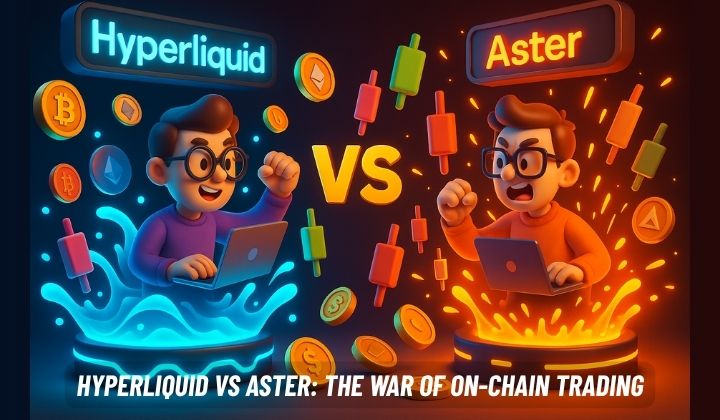
The DEX war has taken to new heights, as Hyperliquid and Aster battle it out to lead the next era of on-chain trading. Hyperliquid might lead the market with over $300 billion in monthly volume amid rising institutional adoption, but Aster isn’t slacking either. The DEX has experienced unprecedented growth since launch, thanks to its innovation and daring experiments in DEX design.
While both have dominated the headlines for the past few months, we can’t deny that the on-chain rivalry between these two is helping to reshape the DEX niche. Before now, the focus was on token incentives to capture the market share, but recently, this philosophy has shifted to speed, sustainability, and leverage to catalyze rapid growth.
With focus on teams behind these two DEX projects and technology, and product philosophy, we will break down how Aster squares up against the giant Hyperliquid, and which is in for the long game as far as dominance is concerned.
The Numbers War: Comparing Hyperliquid’s Liquidity to Aster
Hyperliquid, a decentralized exchange built on its Blockchain, gained a strong reputation and traction among traders and market makers based on execution and deep liquidity.
In mid-2025, it witnessed tremendous growth in 2025, handling more than $300 billion in trading volume and reaching more than $17 billion in daily activity. One of the biggest drivers of Hyperliquid’s growth came from its points-based rewards program.
Back in November, Hyperliquid airdropped approximately 28% of its HYPE token to early and active participants. Described as the most lucrative airdrop launch in modern crypto history, Hyperliquid’s well-executed strategy honed on community involvement, excluding venture capitalists (VCs).
This move forced VCs to join in buying the token along with everyone else, which helped to maintain the price action of HYPE post-launch. The strategy worked out because not only did Hyperliquid succeed in capturing a lion’s share of the market, but the HYPE token skyrocketed from its initial valuation of $1 billion to over $7.5 billion.
Aster, a fast-growing DEX on BNB Smart Chain, tried to implement a similar strategy with its airdrops, staged reward programs, and cross-platform Partnerships. This, it believes, will encourage user onboarding and boost TVL. In some ways, that worked. Reported trading volumes at times surged past Hyperliquid’s, reaching tens of billions of dollars.
Its connection to Changpeng Zhao and cross-platform partnerships have also helped Astra gain significant attention. However, the only trade-off with Aster’s model is heavy reliance on the incentives playbook to bootstrap liquidity may not attract serious participants.
This was the argument of Calder White, Chief Technology Officer of Vigil Labs, when comparing Aster to other DEXs. In essence, Aster’s trading volumes are merely recycled capital. Will this affect Aster’s growth in the future? A look at its growth speculations may answer that.
Growth Trajectories of Hyperliquid and Aster
As mentioned, Aster’s growth is largely due to its heavily-incentivized model and close ties with CZ, who has become an advisor on the project. Because of this, many in the crypto world refer to Aster as “Binance DEX.” Recently, the exchange introduced tokenized stocks, enabling users to trade major assets with up to 1,000 leverage.
Aster also plans to launch its Layer-1 Blockchain soon. It’s apparent that Aster is thinking of the future, and may not entirely continue to rely on its airdrop programs. As far as growth is concerned, the combination of tokenized stocks trading and the launch of Layer-1 Blockchain will heat up competition in the DEX space.
Still, the issue of institutional liquidity entering Aster remains a big concern. On October 5, 2025, Aster airdropped over 320 million Aster tokens worth $600 million to users for generating trading activity. The airdrop translated into strong activity and revenue generation. For example, Aster generated over $20 million from trading fees in 24 hours, placing it among the top revenue earners in DeFi.
However, what happens when the rewards taper off? Will there be continued trading? There’s ongoing speculation that the Aster team may buy back the tokens with part of the earnings gotten from the trading fee. If this happens, Aster token could skyrocket in value and sustain trader interest beyond the airdrops.
Hyperliquid’s growth trajectory has been steady and organic, despite low incentives. This is due to high open interest and accrued real trading firms. The exchange supports institutional-size trades and deep order execution, which benefits high-frequency traders who require minimal slippage.
This sustained high-prep volumes and large cumulative revenues have been key to Hyperliquid’s massive growth. Several reports show that Hyperliquid’s model of strong fee generation and open interest positions it for professional flows.
The question now is which of the two is positioned for long-term growth? Historically in DeFi, platforms that leverage heavily the incentivized model to capture users without long-term values and visionary products end up with a blow.
In contrast, those who keep users even after incentives win the long game. Could Aster’s current incentivized model re-balance when rewards taper off?
Open Interest and Institutional Liquidity: Key Drivers for Infrastructural Adoption
One of the simplest ways to gauge a perpetual DEX is to examine open interest – the total value of all trades still open on a platform. The higher the open interest, the more real money is sitting in positions.
On Hyperliquid, the OI is $13.2 billion, supporting a circulating market capitalization of approximately $15.2 billion. Aster’s open interest, on the other hand, sits at $1.45 billion. Given the statistics, it shows that Hyperliquid’s OI is unmatched.
Now, let’s talk about institutional liquidity. The gradual entry of institutional liquidity to on-chain derivatives is sparking discussions. Once, these funds avoided on-chain derivatives due to slippage and latency concerns.
Now, they allocate test capital to these DEXs, especially Hyperliquid, thanks to its speed-focused and transparent design, which have attracted professional traders. Aster, in contrast, is still gaining traction with its Binance-linked and airdrop narrative, but still trails Hyperliquid.
For liquidity providers and traders, what they care about the most boils down to three metrics – execution quality, depth and open interest, and ease of earning yield.
Hyperliquid scores high on execution and open interest due to low slippage and latency, as well as its depth of trade size. Aster only scores big on economic incentives and raw reward potential.
Who Wins the Long Game? Hyperliquid or Aster?
We love the competition in the DEX space, particularly between Hyperliquid and Aster. The healthy rivalry is certain to improve both ecosystems, which benefits the broader decentralized market. Although both platforms are for different user segments, Hyperliquid’s focus on strong execution quality and product-led retention strategy, positions it for the long game.
The exchange has ramped up efforts to grow institutional traction by introducing game-changing features, such as HIP-3, which allows traders to launch a perp DEX on Hyperliquid’s rails. Hyperliquid is also launching its USDH stablecoin and planning to list perpetuals for tokens like Aster to capture even more institutional flows.
On top of that, Hyperliquid is keeping the community engaged with seasonal rewards. For example, it launched the Hypurr NFT collection September 28, 2025, which became an instant hit.
The floor prices were around 1,200 HYPE (about $55,000) each. This also shows that incentives can be rewarding in moving markets, but remember, Hyperliquid also combines execution and liquidity. By balancing economic incentives, liquidity, and execution, Hyperliquid is likely to win broader adoption.
Aster, on the other hand, is an emerging powerhouse that has taken the DEX market by storm. It has shown how far incentives can stretch the market, but the real test is whether traders can stay after the airdrop noise. If Aster can successfully transition from airdrop-driven growth to real products, it could capture the market faster.
Final Thoughts
Hyperliquid and Aster are two DEX platforms that are capturing attention. Comparing them shows how they fare, and what truly drives adoption. So far, it’s been the case of product value vs. incentive mechanism.
Hyperliquid still commands the lion’s share of the market, but Aster is putting up a fight. Who knows? Aster might overtake Hyperliquid if it’s able to transform short-term growth to long-term trust.
You need to login in order to Like



















Leave a comment